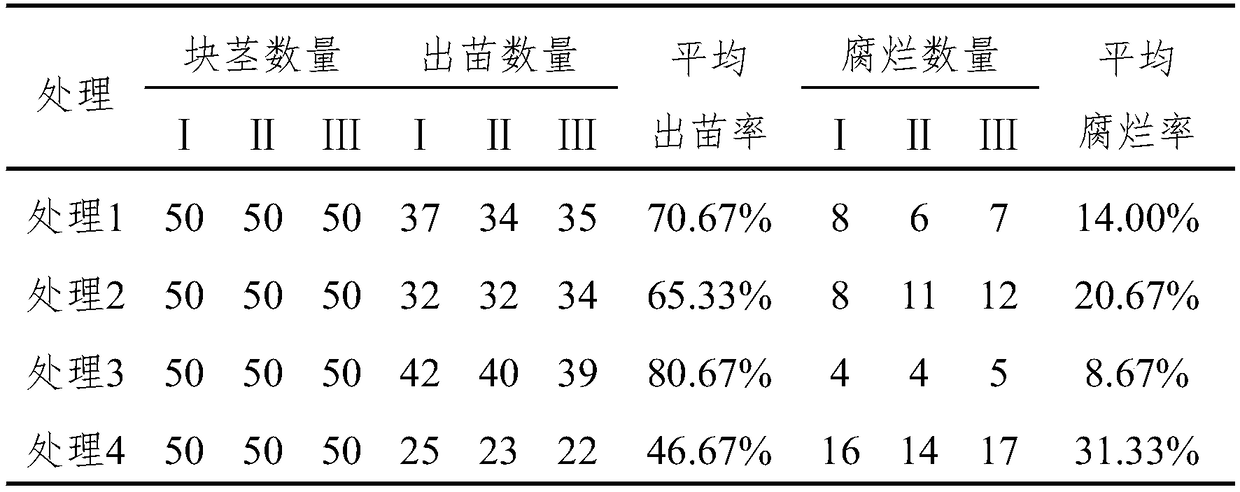Field intensive planting method capable of realizing rapid propagation and used for polygonatum kingianum
A planting method, the technology of Polygonatum yunnanensis, applied in botany equipment and methods, horticultural methods, seed immunity, etc., can solve the problems of unfavorable popularization of planting, uneconomical, difficult collection, etc., to improve germination rate and rooting rate, and increase production benefit, the effect of reducing the pollution rate
- Summary
- Abstract
- Description
- Claims
- Application Information
AI Technical Summary
Problems solved by technology
Method used
Image
Examples
Embodiment 1
[0065] Embodiment one: tuber seedling field intensive planting
[0066] 1 tuber seedling cultivation
[0067] Choose robust, yellowish color, no pests and diseases, no broken skin, and tubers with terminal buds as seedling tubers. Cut the tender part of the apex of Polygonatum yunnanensis tuber into several sections, each section has 2 nodes and 1 to 3 bud eyes. Soak the cut Rhizoma Polygonatum tubers with 30% metalaxyl water for about 5 minutes to form a protective film on the surface of the tubers, and dry them for later use. The treated Rhizoma Polygonatum tubers were planted on the sand bed, and the sand bed was kept moist. The emergence of the tubers was investigated 30 days after planting, and statistics were made once a week thereafter.
[0068] 2 Intensive Planting of Polygonatum Polygonatum in Field
[0069] 2.1 Environmental condition control
[0070] Altitude: The planting site should be in an area with an altitude of 700-3600m and convenient transportation.
...
Embodiment 2
[0098] Embodiment two: Tissue cultivation field intensive planting
[0099] 1 Tissue culture of Polygonatum yunnanensis
[0100] 1.1 Extraction of explants
[0101] From September to October every year, the rhizome buds of Rhizoma Polygonatum plants that have been domesticated and cultivated, are good in growth, large in size, and free from diseases and insect pests are selected as explant materials. .
[0102] 1.2 Disinfection of explants
[0103] When in use, the surface of the Rhizoma Polygonatum Rhizome is brushed with 1% washing powder, rinsed under running water, and the pretreated tuber is cut into small pieces with buds on an ultra-clean workbench to obtain the explant material. The explant material disinfection procedure is as follows:
[0104] (1) 75% alcohol for surface disinfection, disinfection time is 20s;
[0105] (2) Wash with sterile water 2 to 3 times;
[0106] (3) 0.1% mercuric chloride is used for deep disinfection, and the disinfection time is 15 min...
Embodiment 3
[0118] Embodiment three: Exploration of the best disinfection program for tuber seedling cultivation
[0119] 1 tuber of choice
[0120] Choose robust, yellowish color, no pests and diseases, no broken skin, and tubers with terminal buds as seedling tubers.
[0121] 2 tuber treatments
[0122] The biggest problem in the tuber cultivation of Polygonatum yunnanensis at present is that the tubers are easy to rot, resulting in low emergence rate and low quality of seedlings. The purpose of this experiment is to disinfect the tubers of Polygonatum yunnanensis and screen out the best treatment plan, so as to reduce the rot rate of tubers and improve the emergence rate and seedling quality.
[0123]Cut the tender part of the apex of Polygonatum yunnanensis tuber into several sections, each section has 2 nodes and 1 to 3 bud eyes. Carry out the following three disinfection treatments on the tubers:
[0124] Treatment 1: Soak the cut Rhizoma Polygonatum tubers in 1:800 carbendazim ...
PUM
 Login to View More
Login to View More Abstract
Description
Claims
Application Information
 Login to View More
Login to View More - R&D
- Intellectual Property
- Life Sciences
- Materials
- Tech Scout
- Unparalleled Data Quality
- Higher Quality Content
- 60% Fewer Hallucinations
Browse by: Latest US Patents, China's latest patents, Technical Efficacy Thesaurus, Application Domain, Technology Topic, Popular Technical Reports.
© 2025 PatSnap. All rights reserved.Legal|Privacy policy|Modern Slavery Act Transparency Statement|Sitemap|About US| Contact US: help@patsnap.com



